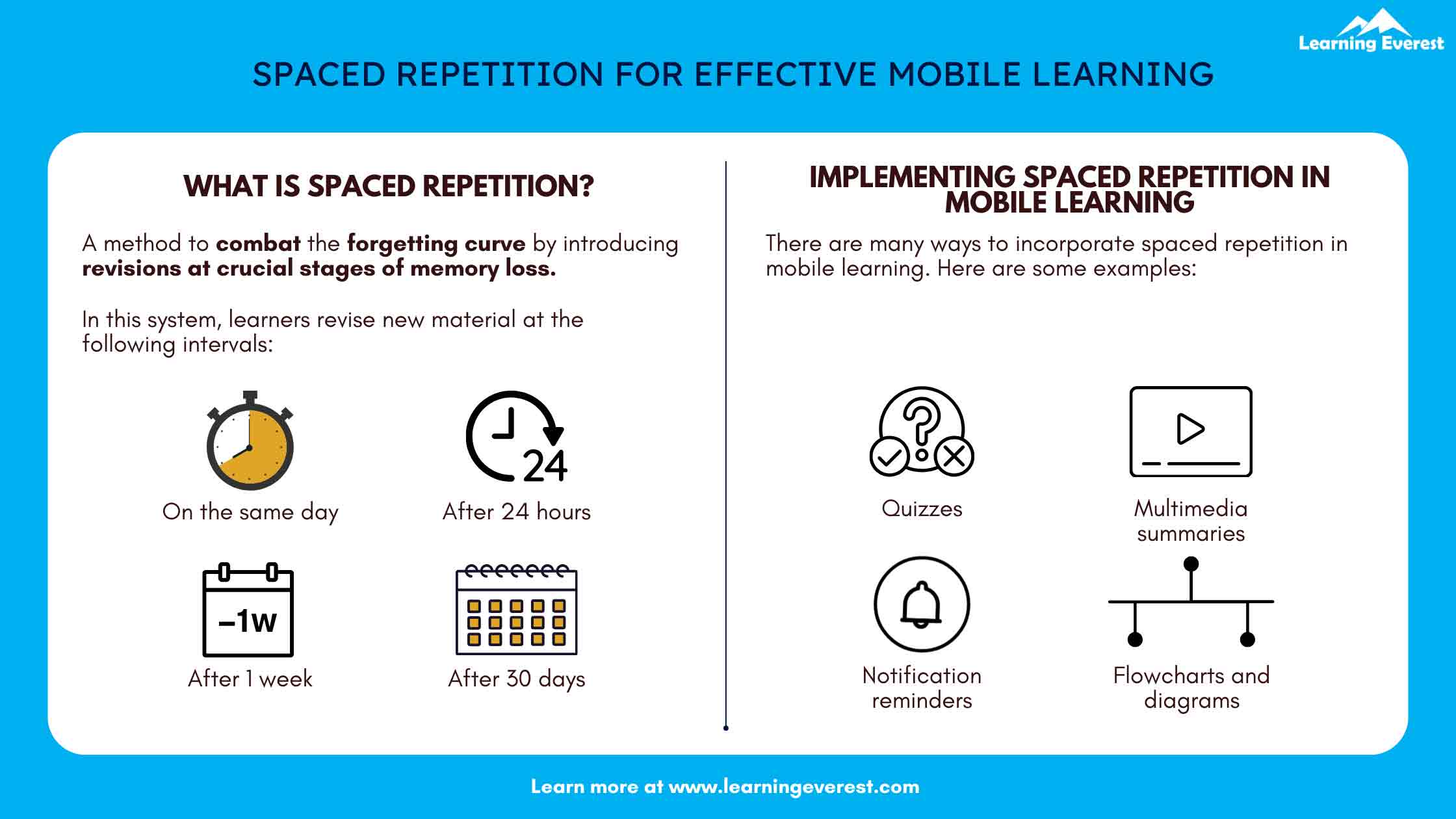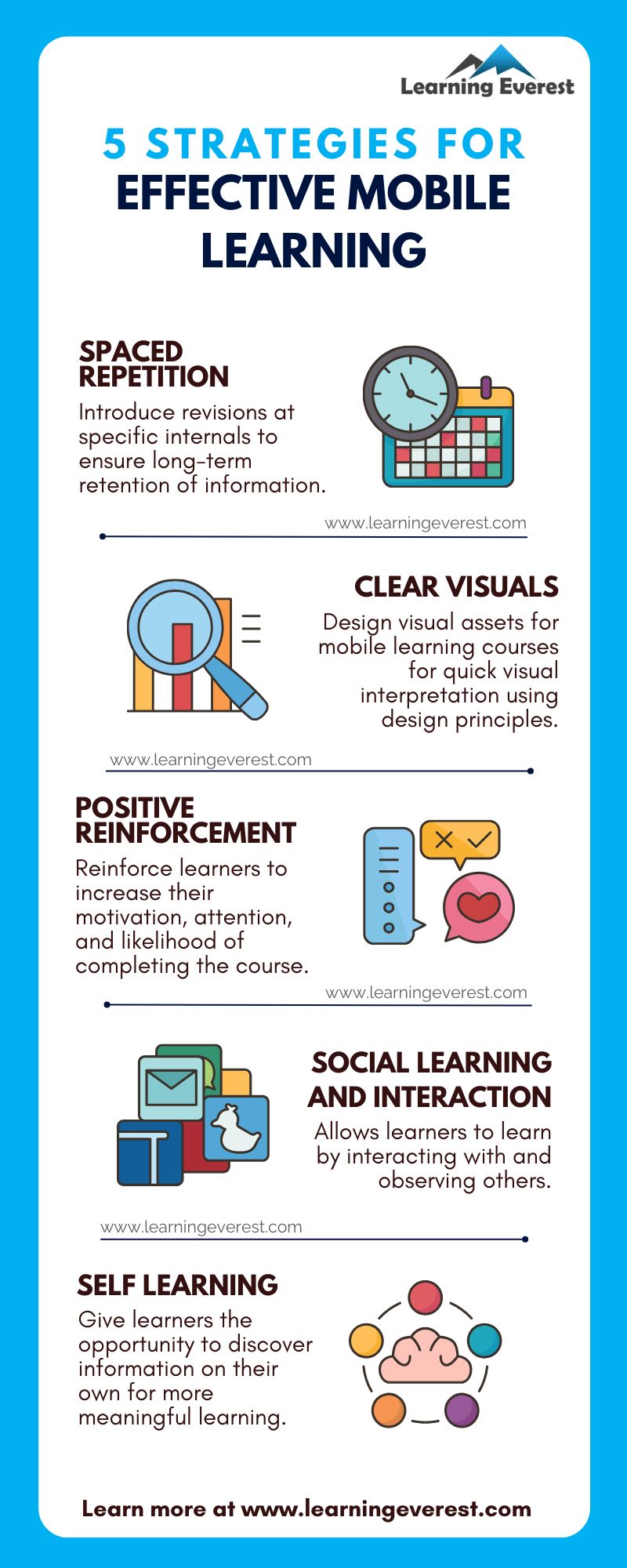Creating effective mobile learning courses requires the use of deliberate tools and strategies that maximize the efficiency of knowledge acquisition. Figures suggest that mobile learning is extremely popular today – accessing training on mobile devices is essential for 64% of learners (Source: Towards Maturity). It has also been shown to increase business improvement and productivity by 55% and 43%, respectively (Source: Gitnux). Hence, whether you are a business that has already adopted mobile learning or are in the process of doing so, the 5 strategies for effective mobile learning mentioned in this article will help you upgrade your courses for impactful learning.
Here are 5 Strategies for Effective Mobile Learning
Spaced Repetition for Effective Mobile Learning
Spaced repetition is one of the oldest tricks in the book for enhanced learning. It is based on the forgetting curve that was given by Hermann Ebbinghaus in 1885.
In Ebbinghaus’ research, he found that the human brain forgets 70% of new information within 24 hours of acquiring it. Over the next 7 days, people forget almost 90% of the information acquired.
Spaced repetition is a method developed to combat the forgetting curve by introducing revisions at crucial stages of memory loss.

Spaced Repetition for Effective Mobile Learning
In this system, learners revise new material at the following intervals:
- On the same day
- After 24 hours
- After 1 week
- And after 30 days of first acquiring the new information
Mobile learning is bite-sized and covers short durations, providing only the most essential information to learners. This is an advantage as learners can simply retake a course to revise. But there are many other ways to incorporate spaced repetition for more effective mobile learning, for instance:
- Short quizzes delivered via an LMS
- Multimedia summaries such as explainer videos, whiteboard animations, infographics, PDFs, etc.
- Notifications that highlight important points or prompt learners with a question or reminder
- Flowcharts and diagrams
Facilitating Quick Visual Interpretation of Content for Effective Mobile Learning
Another great way to ensure effective learning is to organize content in a way that is easy to interpret visually. This mostly applies to visual content, such as graphs, charts, infographics, etc.
Optimize your mobile learning course’s visual assets using design principles such as the Gestalt principles of perception. Design principles will let you organize content in an easily consumable manner, making visual comprehension almost instant for learners.
Some principles you can use are:
- Similarity: Give similar items the same visual form (color, shape, and/or size) so learners know they belong to the same category. For instance, in a bar graph, the bars for the same variable should have the same color.
- Proximity: Group similar items closer together so learners know they are similar in some ways. For example, vertically listing points related to one concept on one side of the screen in a differentiation table.
- Common fate: Common fate is the tendency of people to group elements that seem to “move” in the same direction. This can be used to facilitate simpler visual interpretation for actions like scrolling and swiping. Additionally, the principle of common fate can be used to indicate directions in diagrams, flowcharts, gifs, and animations.
- Closure: Closure refers to the tendency of the human brain to fill up gaps in what it perceives. The principle of closure can be incorporated in progress bars, scoreboards, and result screens.
Design Principles for Mobile Learning Graphics
Positive Reinforcement for Effective Mobile Learning
Positive reinforcement happens when an outcome is followed by a pleasant reward. It facilitates effective mobile learning by increasing learners’ motivation. Motivated learners are more engaged, pay more attention, and are more likely to complete a course.
In mobile learning, positive reinforcement can be used in many different ways, from encouraging feedback to granting points and collectibles.
Positive reinforcement has long been used to increase the frequency of desirable behaviors. In the case of mobile learning, it can be used to elevate and maintain learners’ motivation and mood while taking the course, putting them in an ideal state of mind for learning. It can also be used to emphasize key points through pop-ups or feedback for quizzes and activities.
Social Learning and Interaction for Effective Mobile Learning
Social learning and interaction can also create effective mobile learning experiences. Social learning allows learners to learn by interacting with and observing others. In a mobile learning environment, direct observation is often not possible, so learners observe others’ work, posts, assignments, and interactions to improve their understanding of the subject matter.
Social learning and interaction are beneficial elements to integrate into mobile learning because they improve learner motivation and engagement. Learning within a social network has also been shown to increase learner creativity (Al-Rahmi & Zeki, 2016). Additionally, social learning and interaction make mobile learning a more involved experience, incentivizing courses for learners who prefer a more social learning environment.
So, how can social learning and interaction be incorporated into mobile learning? There are many different ways:
- Chat boxes
- Discussion forums
- Social media integration (such as tweets, Instagram posts, etc.)
- Breakout rooms, live channels, and temporary groups
- Facilitator-led video and audio content
- Photo and video-sharing apps
- Demo videos
These methods range in the level of interaction they offer, and you will need to consider how much social learning is enough for your target learners. For instance, videos are a great way to let learners gain knowledge and skills through observation without directly having to interact with peers. On the other hand, discussion forums allow real-time exchange of ideas among learner groups.
It is important to make participation in more hands-on, informal social learning like forums and chats voluntary. This way, learners have more flexibility regarding how they take the course. It will also prevent these elements from taking away from the learning experience instead of adding to it.
Self-Learning for Effective Mobile Learning
Lastly, you can encourage self-learning in mobile learners to make their learning more impactful. An estimated 30% of mobile users today already use it for self-learning in their day-to-day lives (Source: MindTools). The most common way to do so is by researching topics they want to know more about. Users also gain information through social media posts, blog posts, web series and videos, learning apps, and more. In other words, users today actively use mobile devices to learn things.
L&D professionals can leverage this in their mobile learning courses by encouraging learners to explore and deep-dive into some topics themselves.
This makes for more impactful and meaningful learning as learners discover the information themselves with the resources they can find.
Hence, self-learning activities create effective mobile learning experiences by increasing learners’ involvement in the learning process. When learners encounter information themselves, they actively form connections in their minds about it and have more context for the central points. This ensures that learners retain self-learned information for a long time.
Conclusion
Businesses today have a multitude of tools to create effective mobile learning courses for their learners. Going the extra mile to incorporate certain features into your mobile learning courses can greatly improve their impact. By carefully considering your target audience, learning objectives, and the subject matter of the course you’re building, you can pick the best mobile learning strategies for your specific use case and deliver compelling mobile learning to your learners.
Infographic
Knowledge Check!
Frequently Asked Questions (FAQs)
How can I improve my mobile learning?
Some ways to improve mobile learning are:
- Spaced repetition
- Easy to interpret graphics
- Positive reinforcement
- Social learning and interaction
- Incorporating self-learning
What is the effectiveness of mobile learning?
Mobile learning is effective because it produces higher learner motivation and engagement, making them more involved and attentive throughout the learning process.
What are the examples of mobile learning?
Mobile learning is very versatile. Some examples include:
- Videos
- Infographics
- Text resources
- Self-learning and research
- Community learning through discussion forums, chats, and specialized learning apps
- Learning through social media
References
Al-Rahmi, W. M., & Zeki, A. M. (2017). A model of using social media for collaborative learning to enhance learners’ performance on learning. Journal of King Saud University – Computer and Information Sciences, 29(4), 526–535.







